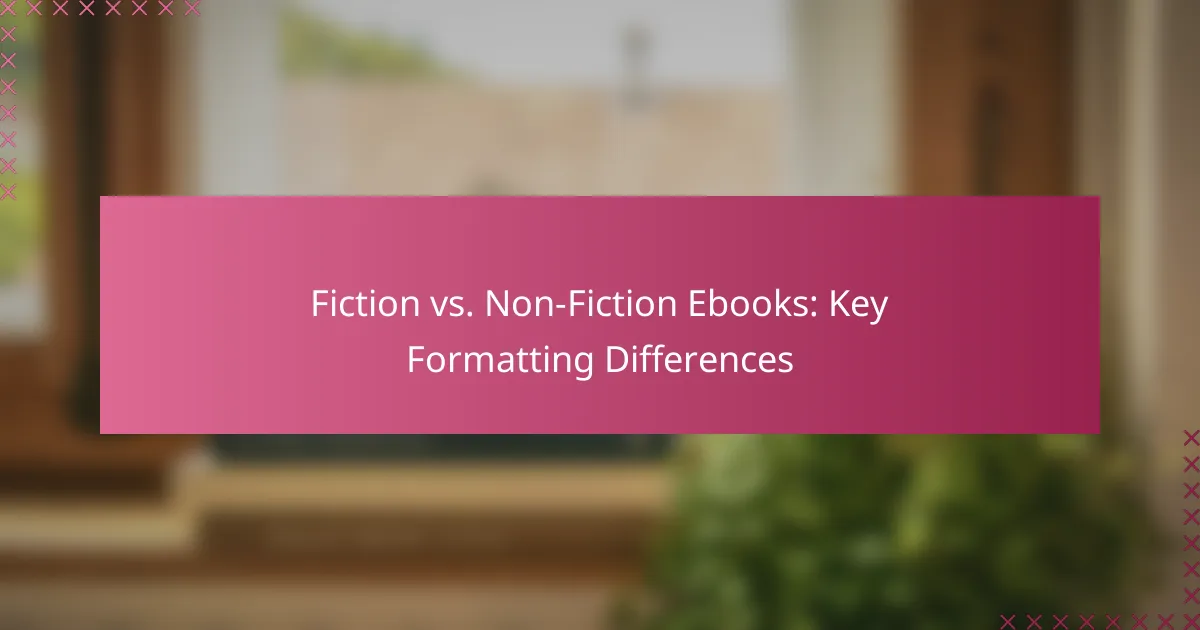Understanding the key formatting differences between fiction and non-fiction ebooks is essential for both writers and readers. Fiction emphasizes narrative flow and creative layouts to enhance storytelling, while non-fiction prioritizes clarity and organization to effectively present information. These distinctions extend to font choices as well, with fiction often using serif fonts for a traditional feel, and non-fiction favoring sans-serif fonts for improved readability.
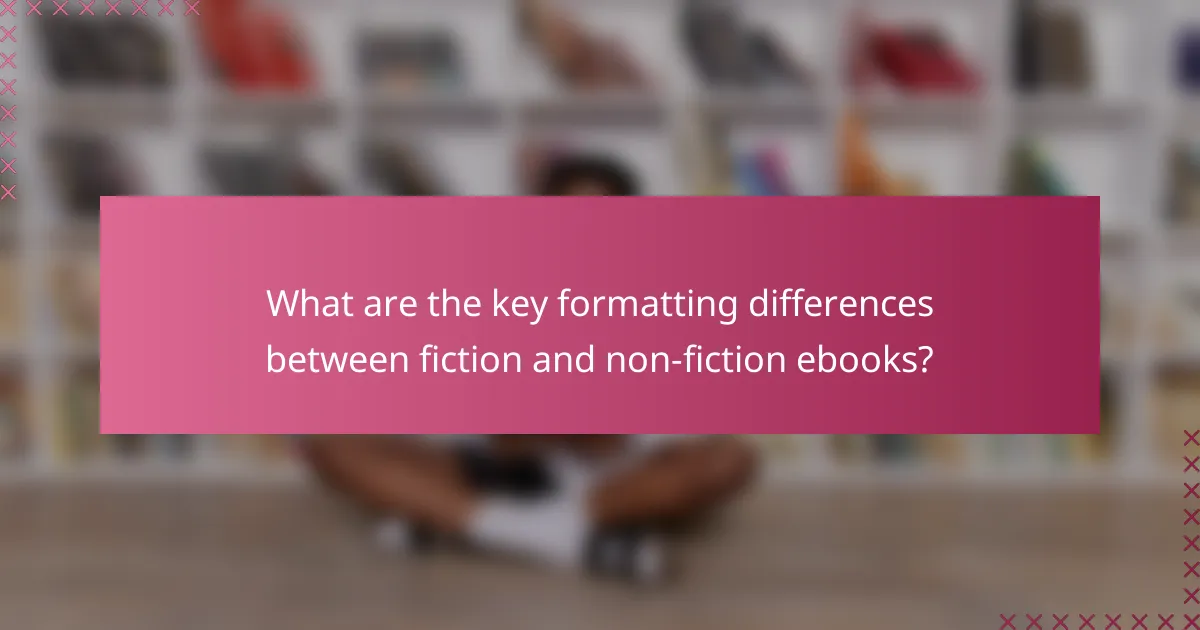
What are the key formatting differences between fiction and non-fiction ebooks?
The key formatting differences between fiction and non-fiction ebooks revolve around narrative style and structural clarity. Fiction prioritizes storytelling flow, while non-fiction focuses on presenting information in an organized and accessible manner.
Fiction formatting emphasizes narrative flow
Fiction formatting is designed to enhance the reading experience by ensuring a smooth narrative flow. This includes using appropriate line spacing, paragraph indentation, and font choices that support immersion in the story. For instance, a standard font size of 11-12 points is common, with generous line spacing to make reading comfortable.
Additionally, fiction often employs chapter breaks and scene transitions to guide readers through the plot. Authors may choose to include visual elements like illustrations or decorative chapter headings to enhance engagement. However, it’s crucial to avoid excessive formatting that could distract from the narrative.
Non-fiction formatting prioritizes clarity and structure
Non-fiction formatting focuses on clarity and organization to facilitate understanding of complex information. This often involves using headings, subheadings, bullet points, and numbered lists to break down content into digestible sections. A common practice is to use a larger font size for headings (14-16 points) to distinguish them from the main text.
Charts, tables, and images are frequently incorporated to support data presentation and illustrate key concepts. It’s important to ensure that these elements are clearly labeled and referenced within the text to maintain coherence. Avoid cluttering the layout with unnecessary graphics, as this can detract from the main message.
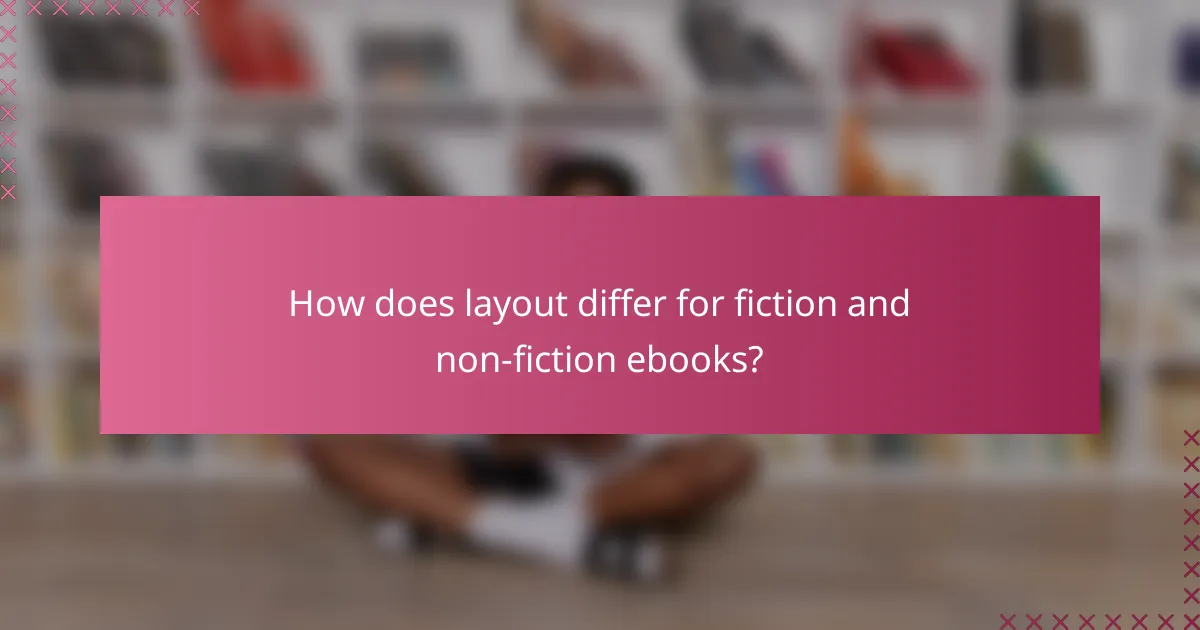
How does layout differ for fiction and non-fiction ebooks?
The layout for fiction and non-fiction ebooks varies significantly, primarily in terms of design and readability. Fiction often embraces creative layouts to enhance storytelling, while non-fiction prioritizes clarity and straightforward presentation of information.
Fiction uses creative layouts with varied fonts
Fiction ebooks typically feature imaginative layouts that may include different font styles, sizes, and colors to create an engaging reading experience. Authors and designers often experiment with chapter headings, illustrations, and even text placement to evoke emotions and immerse readers in the narrative.
For example, a fantasy novel might use ornate fonts for chapter titles, while a romance story may incorporate playful typography. These creative elements can enhance the thematic aspects of the story but should be balanced with readability to avoid distracting the reader.
Non-fiction employs standard layouts for readability
Non-fiction ebooks generally adopt standard layouts that emphasize clarity and ease of navigation. This includes consistent font choices, clear headings, and structured formatting that allows readers to quickly locate information. Bullet points, numbered lists, and tables are commonly used to present data succinctly.
For instance, a self-help book may use headings and subheadings to break down concepts, while a technical manual might rely on tables to compare data. Maintaining a clean and organized layout is crucial in non-fiction to facilitate comprehension and retention of information.
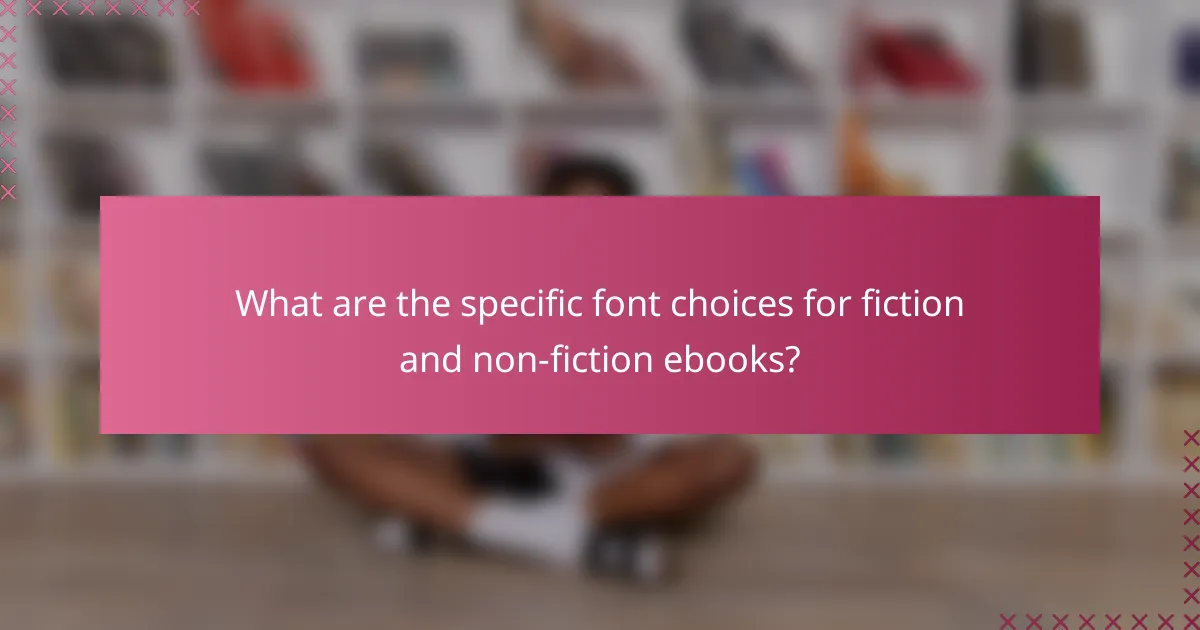
What are the specific font choices for fiction and non-fiction ebooks?
Fiction and non-fiction ebooks often employ different font styles to enhance readability and convey their respective tones. Fiction typically favors serif fonts for a traditional storytelling feel, while non-fiction leans towards sans-serif fonts for clarity and straightforward presentation.
Fiction often uses serif fonts for storytelling
Serif fonts, characterized by small lines or decorative strokes at the ends of letters, are commonly used in fiction ebooks. These fonts, such as Times New Roman or Garamond, create a classic and immersive reading experience, which can enhance the narrative flow.
When selecting a serif font for fiction, consider readability at various screen sizes. A font size of 12-14 points is generally effective for most readers, ensuring comfort during extended reading sessions.
Non-fiction typically uses sans-serif fonts for clarity
Sans-serif fonts, which lack the decorative strokes found in serif fonts, are preferred in non-fiction ebooks for their clean and modern appearance. Fonts like Arial or Helvetica are popular choices, as they promote easy reading and comprehension of complex information.
For non-fiction, aim for a font size of 10-12 points to maintain clarity without overwhelming the reader. Utilizing ample white space and clear headings can further enhance the readability of non-fiction content.
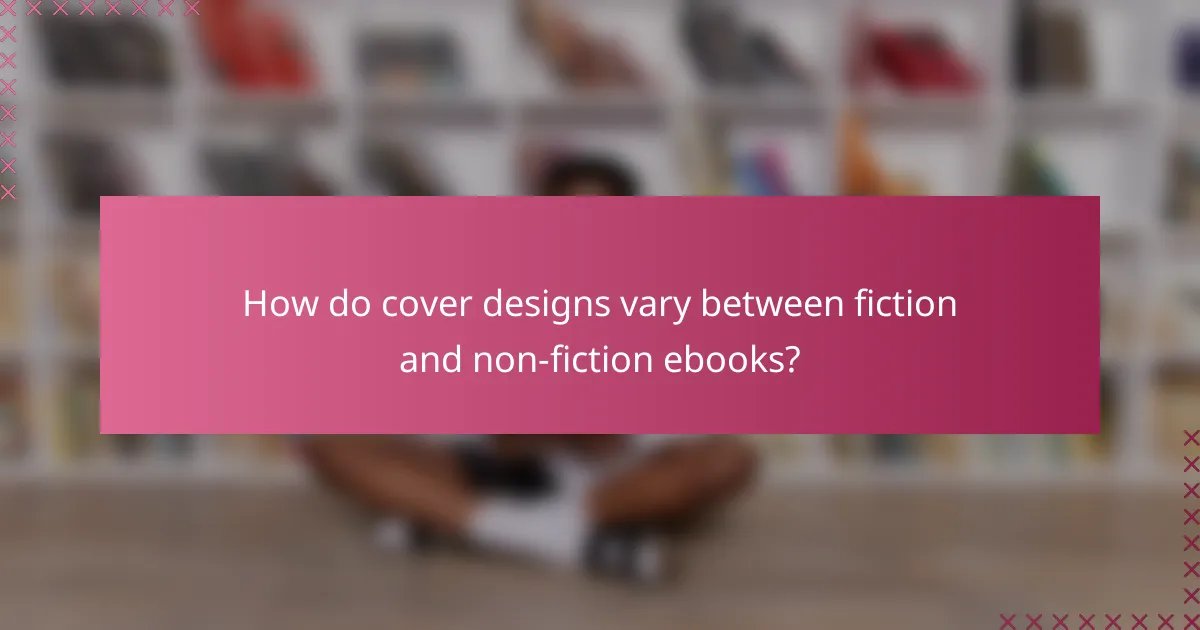
How do cover designs vary between fiction and non-fiction ebooks?
Cover designs for fiction and non-fiction ebooks differ significantly in their focus and presentation. Fiction covers often emphasize artistic elements to evoke emotions, while non-fiction covers prioritize clarity and informative graphics to convey the subject matter effectively.
Fiction covers focus on artistic imagery
Fiction ebook covers typically feature vibrant and imaginative artwork that captures the essence of the story. This artistic imagery is designed to attract readers’ attention and evoke curiosity about the narrative within. Elements such as illustrations, typography, and color schemes play a crucial role in setting the tone of the book.
When designing a fiction cover, consider using illustrations that reflect key themes or characters. For instance, a fantasy novel might showcase a mythical creature, while a romance might feature a couple in an intimate setting. The goal is to create a visually compelling image that draws potential readers in.
Non-fiction covers highlight informative graphics
Non-fiction ebook covers are generally more straightforward and focus on informative graphics that communicate the book’s subject matter. This can include charts, diagrams, or photographs that provide a clear indication of the content. The design aims to convey professionalism and credibility, appealing to readers looking for knowledge or insights.
In creating a non-fiction cover, prioritize clarity and readability. Use bold titles and subtitles to highlight key topics, and consider incorporating a relevant image that reinforces the book’s theme. For example, a self-help book might feature a serene landscape, while a business guide could include a graph illustrating growth trends.
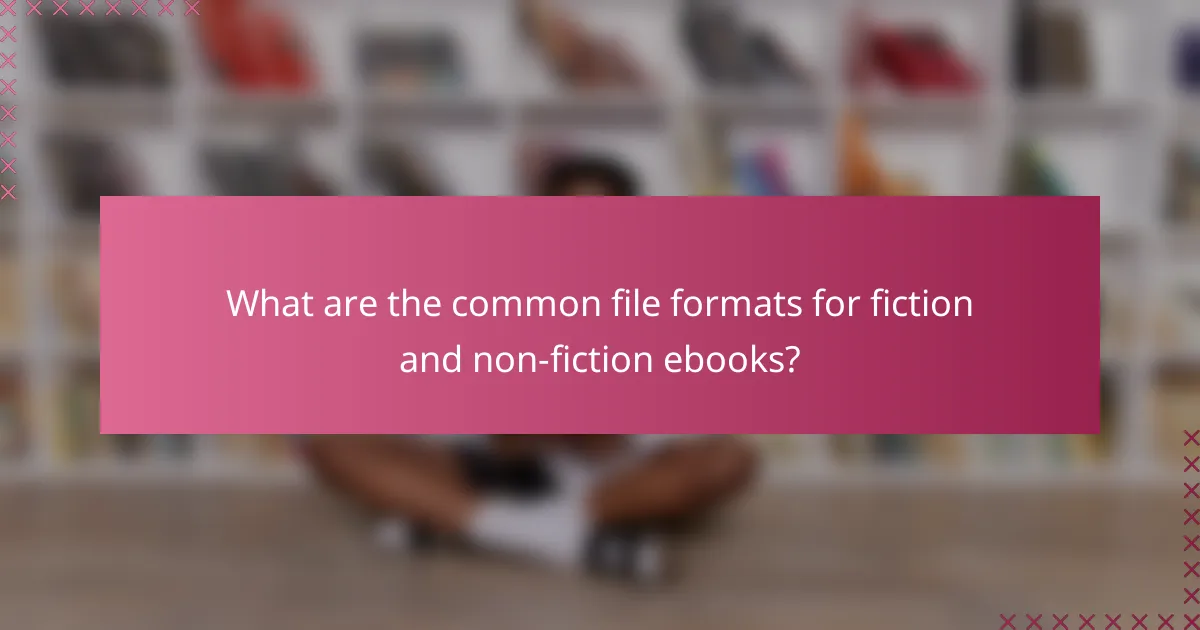
What are the common file formats for fiction and non-fiction ebooks?
The most common file formats for fiction and non-fiction ebooks differ primarily in their design and functionality. Fiction often favors formats that support enhanced features, while non-fiction typically relies on formats that maintain fixed layouts for complex content.
Fiction often uses EPUB for enhanced features
EPUB is a widely used format for fiction ebooks due to its ability to support interactive elements, such as embedded audio, video, and animations. This flexibility allows authors to create a more engaging reading experience, which is particularly appealing for genres like fantasy and science fiction.
Additionally, EPUB files are reflowable, meaning the text can adjust to fit various screen sizes and orientations. This adaptability is crucial for readers using different devices, from smartphones to e-readers.
Non-fiction frequently uses PDF for fixed layouts
Non-fiction ebooks often utilize PDF format because it preserves the original layout of the document, ensuring that charts, graphs, and images appear exactly as intended. This is essential for educational materials, technical manuals, and reference books where precise formatting is critical.
While PDFs are less flexible than EPUBs, they are ideal for documents that require a consistent presentation across different platforms. Readers can expect the same visual experience whether they view the file on a computer or a tablet.

What are the best practices for formatting fiction ebooks?
Effective formatting for fiction ebooks enhances readability and engages readers. Key practices include using chapter breaks and consistent styling, as well as incorporating interactive elements to create a more immersive experience.
Use chapter breaks and consistent styling
Chapter breaks are essential in fiction ebooks as they provide clear transitions between sections, allowing readers to digest the story in manageable parts. Aim for a consistent style in headings, fonts, and spacing to create a cohesive look throughout the book.
Consider using larger font sizes for chapter titles and maintaining uniform margins. This not only improves aesthetics but also aids navigation. A common practice is to use a font size of 12-14 points for body text and 16-20 points for chapter headings.
Incorporate interactive elements for engagement
Interactive elements can significantly enhance the reader’s experience in fiction ebooks. Features like hyperlinks to character profiles, maps, or additional content can provide deeper context and enrich the narrative.
Consider adding multimedia elements such as audio clips or illustrations that complement the story. However, ensure these features do not distract from the reading experience. A balanced approach is key; too many interactive elements can overwhelm readers.
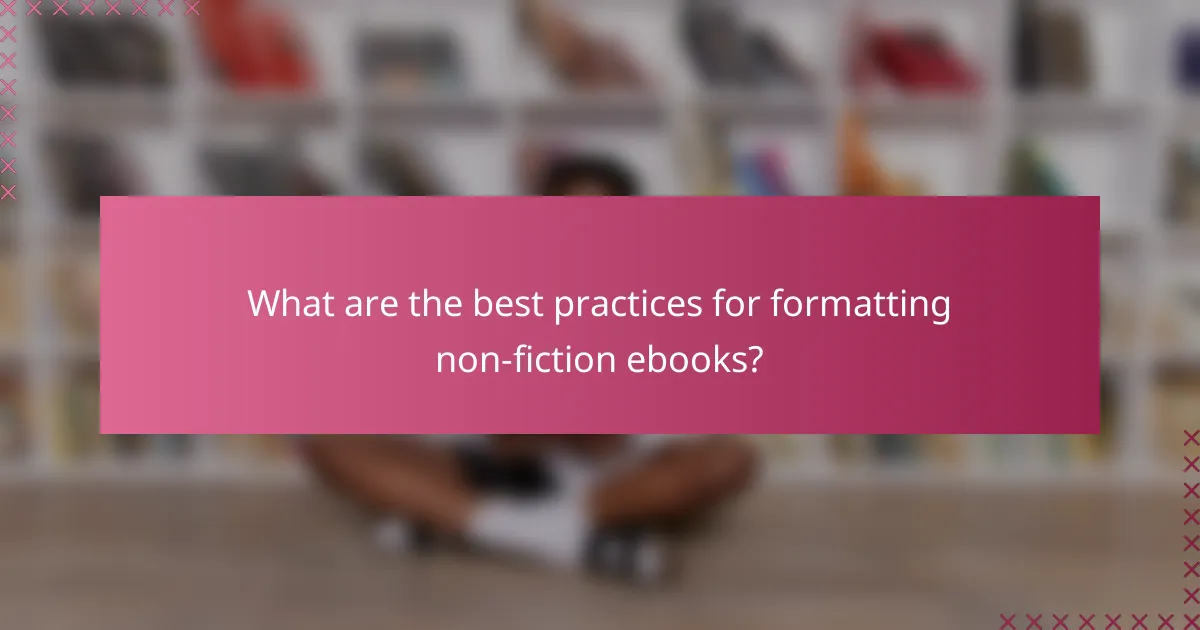
What are the best practices for formatting non-fiction ebooks?
Best practices for formatting non-fiction ebooks focus on enhancing readability and accessibility. This includes structuring content clearly, using visual aids, and providing additional resources to support the text.
Include tables and bullet points for clarity
Using tables and bullet points can significantly improve the clarity of non-fiction ebooks. Tables are effective for presenting data comparisons, while bullet points help break down complex information into digestible chunks.
For instance, when discussing statistics or processes, a table can succinctly display figures side by side, making it easier for readers to grasp key differences. Bullet points can summarize main ideas or steps, allowing readers to quickly scan for essential information.
Utilize hyperlinks for additional resources
Hyperlinks are a valuable tool in non-fiction ebooks, providing readers with direct access to additional resources. By linking to relevant articles, studies, or websites, authors can enhance the reader’s understanding and engagement with the material.
When incorporating hyperlinks, ensure they are relevant and lead to credible sources. For example, if discussing a scientific concept, linking to a peer-reviewed journal article can lend authority to your claims. Avoid overloading the text with links; instead, use them strategically to support key points without distracting from the main content.
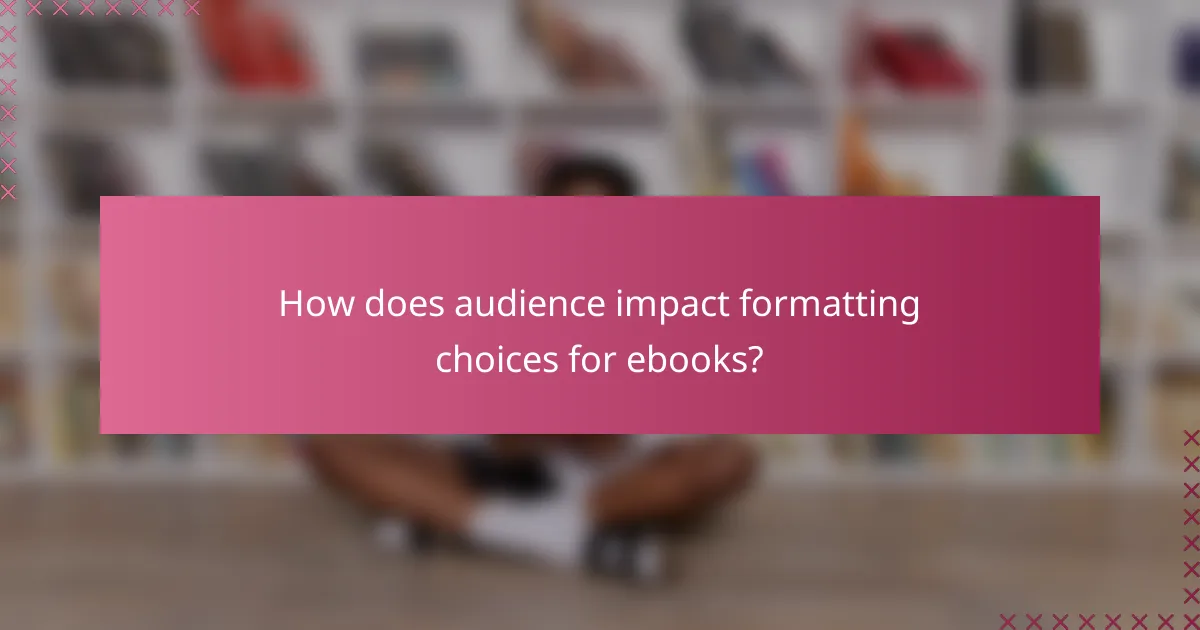
How does audience impact formatting choices for ebooks?
The audience significantly influences formatting choices for ebooks, as different genres and reader preferences dictate how content is presented. Fiction readers often seek an immersive experience, while non-fiction audiences prioritize clarity and accessibility. Understanding these differences helps authors and publishers tailor their ebooks effectively.
Fiction targets immersive reading experiences
Fiction ebooks are designed to captivate readers, often using formatting that enhances the storytelling. This can include varied font styles, larger line spacing, and strategic chapter breaks to create a smooth reading flow. The goal is to minimize distractions and allow readers to become fully engaged in the narrative.
In fiction, visual elements like cover art and illustrations can also play a crucial role. These elements should be high-quality and relevant to the story, as they help set the tone and attract the target audience. For instance, a fantasy novel may use ornate fonts and vibrant colors, while a thriller might opt for darker, more subdued designs.
Authors should consider the pacing of their narrative when formatting. Short paragraphs and frequent scene breaks can maintain tension and keep readers turning pages. Avoid cluttered layouts that can disrupt the reading experience, and ensure that the ebook is optimized for various devices, including tablets and e-readers.
